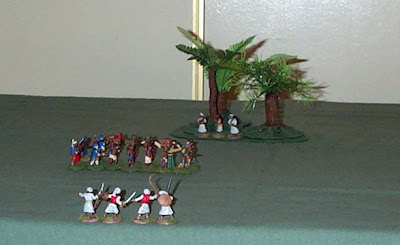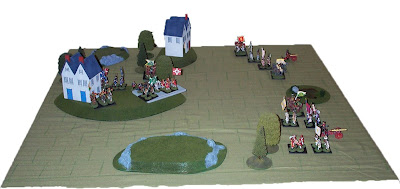As I mentioned in my previous post this is a battle on the North-by-Northwest Frontier I played out with the Pith Helmet rules. One interesting thing about these rules, especially for a solo player, is the reaction system where units react to being fired on, having enemy units approach within a certain distance, or upon being charged. Sometimes these reactions can work to your favor, Other times they can get in the way of your plans. Also, casualties are not necessarily gone. I highly recommend reading the reports on the
Kelroy Was Here blog and also downloading the rules and the accompanying files which include a battle report by the rules author.
The situation I laid out was a patrol comprised of the Grand Thidwick 1st and 2nd regiments, a unit of Gunderland Highlanders, all with 6 figures including 1 leader and 1 NCO, and using the British stats in the rules. Along with them were a unit of Djahli natives, 'the Mongoose regiment", using the Punjabi stats. They were up against a number of hill tribesmen using the Pathan stats.
I set up some terrain on my table (40 inches square), and placed a die at each terrain element to represent potential forces. When the force was encountered by the patrol, which I decided would mean getting within the range that would cause a reaction test, or If it looked like it was a good time to activate any unit, I would roll 1d6 and place one of the units (randomly determined from several possible units I had set aside) on the table. In the meantime they would still get Action Points as described in the rules and could act if need be.
Here is the valley as the first two units of the patrol, Grand Thidwick 1 and the Mongooses approach along a dirt road.
Turn 1.
As they approach both the patrol and the Pathans react hastily to events (1 unit on each side can use 1 action point - the die next to each unit shows the number of action points they have. I turned the die to 6 when the unit was out of action points - in future games I might try some other sort of markers that don't look so out of place). Luckily for the patrol there were no tribesmen in the first set of hills to their right, but there was a group in the woods and rocks to the left. 6 figures, half with rifles and half with swords and shields. These came charging out towards the column.
The charging tribesmen move in closer and fire at the Grand Thidwick unit, but no one is hit. The Grand Thidwick unit reacts by changing formation into line to face the tribesmen. They then fire off a volley at the tribesmen, inflicting no casualties but still cause them to become shaken. Meanwhile the Mongooses move up and I bring on Grand Thidwick 2.
At this point I decided to bring out all of the native units as that would allow many of them to start participating in the battle. So a unit of 6 rifles and 2 sword and shields armed tribesmen run down off the little outcropping with a lone pine tree and head towards the column. 4 cavalry, half with rifles and half with sword and shield, emerge from the rocks and trees just past the little outcropping. They ride fast towards the column (I moved them 2 moves). On the far hills on the upper left 6 natives with rifles, 1 with a pistol, and 2 with sword and shield pop up, but hold their position for now. And yet another group, with 5 rifles and 1 spear appear in the woods to the upper right. These also hold their position. That's the lot.The Mongooses and Grand Thidwick 2 fire at the first group of natives, inflicting 3 casualties, including the "NCO". The natives' reaction is to hold their ground.

Next, Grand Thidwick 1 also fires at the first group of natives, inflicting 2 more casualties. The Highlanders are brought on board.
2 of the natives are dead, 3 more return to the unit.
Turn 2.
The native cavalry fire at Grand Thidwick1, scoring 1 hit. Grand Thidwick 1 reacts by changing formation to face the cavalry. The native cavalry fire again, scoring 2 hits including the NCO. Grand Thidwick reacts by firing back but score no hits. The Mongooses fire at the second native infantry group as it approaches and score a hit. The natives retreat 6 inches and are shaken. The Mongooses then move up to support Grand Thidwick 1 and fire at the native cavalry, scoring no hits. The cavalry fire back, also missing.
The Highlanders move up, change into line formation and fire at the first group of natives, scoring 1 hit. The natives hold.
Grand Thidwick 2 fire at the first group of natives, scoring 2 hits including the "NCO". The natives fall back 4 inches. Grand Thidwick 2 move forward and fire at the natives again, scoring 1 more hit. All of the natives from this first group are now out of commission (in the "Rally Zone").
The Mongooses fire at the native cavalry again, scoring another hit, this time on the unit's "NCO". The cavalry retreat 4.5 inches and are shaken.
The native group in the far hill, seeing many of their brethren in trouble, decide to move down off the hill and run towards the fighting (4 moves, bringing them close to the fighting very quickly). The Highlanders and Mongooses move up in line to support Grand Thidwick 1.
Now we see what happens to the various casualties. The leader and "NCO" from the first group of natives die and the 2 remaining troops rout. The one casualty from the second group of natives dies. The casualty from the native cavalry returns to his unit. All of the casualties from Grand Thidwick 1 return. The few remaining figures in the first group of natives rally. The second group of natives and the native cavalry also rally.
Turn 3.
The native cavalry move farther down the road and the second group of natives also move in closer. The Mongooses fire at the cavalry, scoring 2 hits, but this only seems to infuriate the cavalry who react by advancing towards the Mongooses. Grand Thidwick 1 also fires at the cavalry, scoring another hit, but the cavalry hold. Grand Thidwick 1 then fires at the second group of natives, scoring 2 hits. The natives hold. The Highlanders fire at the second group of natives also and score another hit. The natives still hold. Then Grand Thidwick 1 fires at the natives yet again, scoring one more hit. The second group of natives moves forward and fires at Grand Thidwick 1, but they seem to be a bit rattled and score no hits. Grand Thidwick hold. The third group of natives, from the hills, quickly move in and fire at Grand Thidwick 1, but also score no hits. Grand Thidwick 1 fires at the third group of natives and scores 1 hit.
The Mongooses fire at the cavalry, scoring 1 hit, which puts them all out of commission (in the "Rally Zone). Then a couple of rounds of firing by the Highlanders and the third group of natives has no effect.
Grand Thidwick 2 fires at the second group of natives, scoring 1 hit, and the natives are now shaken.
At this point all of the native units had used up their Action Points, but the Soweiter forces had points left to use, so I just let them act. This involved a flurry of volleys all along the line, resulting in casualties in all of the remaining native units and all of them becoming shaken (except for the 1 unit still in the woods farther up the road)
Settling up the score, sees the casualties in the first group of natives recover, 4 dead in the second group and 2 returns, 1 dead in the third group, 1 cavalry captured and 1 joining in with the third group of natives and 2 more routing up the valley.
Turn 4.
The Mongooses fire at the third group of natives, scoring 1 hit. The natives become shaken and run away. The second group of natives decide to head the the rocky area below the far hills. Meanwhile the natives in the woods decide to join the fighting, so they move down the road, firing twice at the Mongooses, but scoring no hits and the Mongooses hold their ground. Then the Mongooses return fire at these natives, scoring 2 hits. Grand Thidwick also fire at the same group of natives, scoring 2 more hits. The natives return fire, scoring 1 hit on Grand Thidwick 1.
At this point I decided to "call the game". The natives are pretty chewed up, while the Soweiter forces are doing quite well. It doesn't seem likely that the natives can prevail.
This was a fun game, although I may have to give the natives more forces next time! As it happens the recovery phase seems to favor more non-native forces returning to battle, so the natives tend to get whittled down. Or maybe the Colonial forces got lucky this time. Over all, with note-taking and picture-taking (which I forgot to do at points in the "heat of the action"), I played this out over the course of 3.5 to 4 hours in 2 evenings. I confess the format of the rules was a bit off-putting for me, so I reformatted them to better fit my taste (and my eyes, which means a larger font size!), which resulted in 6 pages including the various tables. Still, it's a very concise set of rules, with some interesting mechanisms that make for a somewhat unpredictable game, especially the reactions to events and the casualty recovery and the Action Points and activation systems, great for solo play. And it seemed to work well on my small table and few figures with only minimal adjustments (really all I did was halve all distances, but not casualties or anything else).





















































